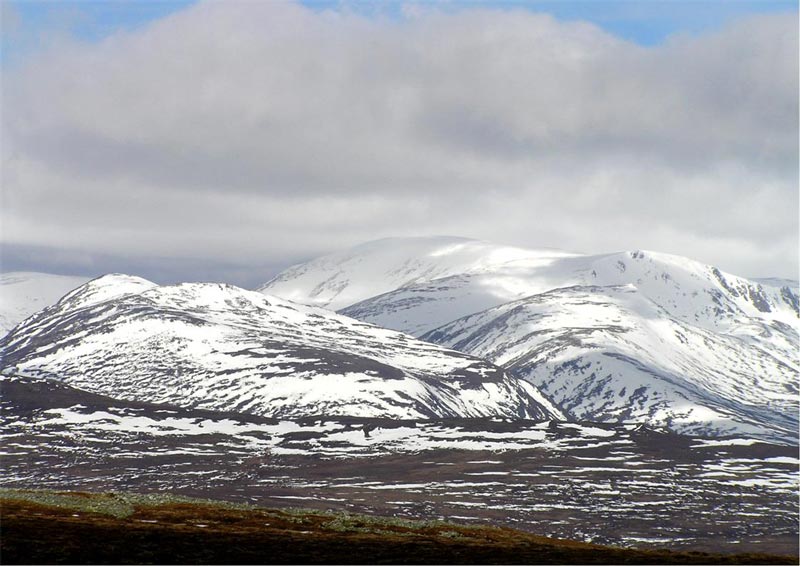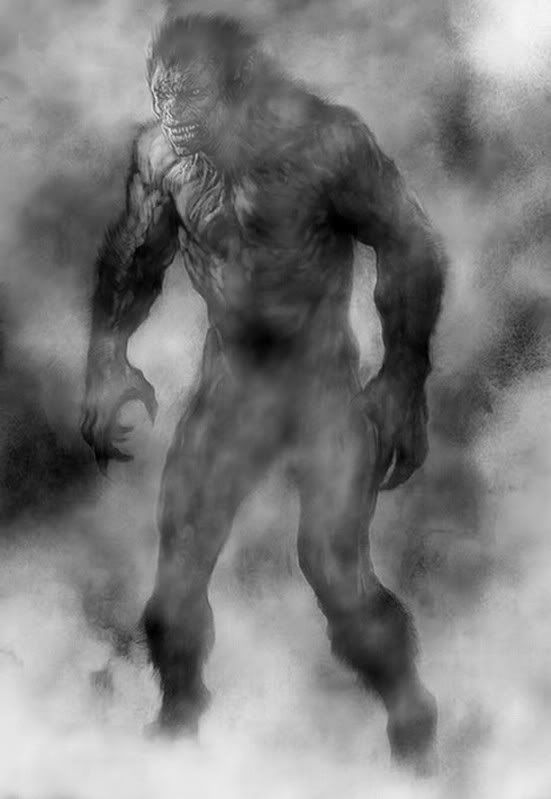The Gray Man of Ben MacDhuiby John May
Like one, that on a lonesome road
Doth walk in fear and dread, And having once turned round walks on, And turns no more his head; Because he knows, a frightful fiend Doth close behind him tread. Samuel Taylor Coleridge Rime of the Ancient Mariner (1834) Rising to 4,295 feet, Ben Macdui is the highest peak in the Cairngorm plateau and the second highest mountain in Scotland. While the terrain is rugged, with extensive boulder fields, cories, cliffs and buttresses at the peak and the weather mostly cold and nasty, many climbers trek up Ben MacDhui’s slope to take in the incredible views seen from its summit. For most climbers, the greatest fear of tackling Ben Macdui can be meeting up with a mysterious being said to haunt the upper regions of the mountain. Ben MacDhui's famous Grey Man (Am Fear Liath Mòr in Scottish Gaelic) first hit the headlines in 1925, when the Cairngorm Club Journal published a story recounting the incredible tale detailed at that year's Annual General Meeting of the Cairngorm Club in Aberdeen by the club's Honorary President, Professor John Norman Collie. In addition to the being the first Professor of Organic Chemistry at the University of London and a Fellow of the Royal Society, Collie was seen as one of the most proficient and esteemed mountaineers of the time. Collie's wide climbing experience ranged from the Himalayas to the Rockies. Described as "shy and reserved with strangers," it must have been a shock to many when the guest speaker recounted an experience he claimed occurred on the summit of Ben Macdui in 1891: "I was returning from the cairn on the summit in a mist when I began to think I heard something else than merely the noise of my own footsteps. Every few steps I took I heard a crunch, then another crunch as if someone was walking after me but taking steps three or four times the length of my own. I said to myself ‘this is all nonsense’. I listened and heard it again but could see nothing in the mist. As I walked on and the eerie crunch, crunch sounded behind me I was seized with terror and took to my heels, staggering blindly among the boulders for four or five miles nearly down to Rothiemurchus Forest. Whatever you make of it I do not know, but there is something very queer about the top of Ben MacDhui and will not go back there again by myself I know.” Today, skeptics maintain the story was fictitious, perhaps the result of a drunken storyteller, or Collie annoyed he was unexpected asked to speak at a climbing club dinner in Edinburgh with no previous notice, stood up and manufactured the tale. No matter what the reason, once Collie's tale was made public, the floodgates were opened, and reports of the Grey Man came flooding in. In the majority of these stories nobody saw any ghost or apparition, with many climbers reporting hearing "a crunching noise" and "overcome by a feeling of apprehension." The most famous sighting of the Grey Man was detailed in the June 1958 issue if The Scots. Alexander Tewnion after ten days of climbing in the Cairngorms in October 1943 reached the summit of Ben MacDhui. As dense mists rolled in from Lairig Ghu, Tewnion noted: I am not unduly imaginative, but my thought flew instantly to the well-known story of professor Collie and the Fear Liath Mhor [Big Grey Man]. Then I felt the reassuring weight of the loaded revolver in my pocket. Grasping the butt, I peered about in the mist here rent and tattered by the eddies of wind. A strange shape loomed up, receded, came charging at me! Without hesitation I whipped out the revolver and fired three times at the figure. When it still came on I turned and hared down the path, reaching Glen Derry in a time that I have never bettered. You may ask was it really the Fear Laith Mhor? Frankly, I think it was. Many times since then I have traversed MacDhui in the mist, bivouacked out in the open, camped on its summit for days on end on different occasions—often alone and always with an easy mind. For, on that day I am convinced I shot the only Fear Liath Mhor my imagination will ever see. There have been many theories put force to explain the Grey Man, ranging from the scientifically laughable to laudable. Some of the more ludicrous notions include the Grey man being a long-lost cousin of Bigfoot; a manifestation of the spirit of the mountain created psychically in the viewers mind; guardian who guards a portal between two worlds on Ben MacDhui. Of course, if none of the above sound plausible, maybe it is possible the Grey Man is actually a "Bodhisattva," one of five perfect men who have lived for billions of years and control the destinies of the world and meet once a year in a cave in the Himalayas. While these theories are amusing, the sad truth is the Grey Man dissipates under close inspection. While Norman Collie's tale is the most famous, it is easily dismantled when one looks at the source. Christine Mill, Collie's biographer explains how Collie was a lifelong believer in the occult. Mill also notes Collie would often tell stories around the campfire or in his den of Gaelic mountain gods and goddesses, and other legendary creatures; and as she put it, "No one quite knowing how much he was believing himself." For other climbers who have stated they have seen a spectral giant, that mystery was solved as early as 1791 when the poet James Hogg, out tending sheep on Ben MacDhui saw "a giant blackamoor, at least thirty feet high, and equally proportioned, and very near me. I was actually struck powerless with astonishment and terror." Terrified, Hogg fled back to his home. The next day, when making the same journey, Hogg once more came upon the same apparition. This time, instead of fleeing, he decided to perform an experiment. Upon removing his hat, Hogg observed the figure do the same thing and quickly realized what he saw was simply his own shadow in the fog. This atmospheric effect would later make its way into Hogg's 1824 novel, Confessions of a Justified Sinner. The technical term for what Hogg experienced is known as a Brocken Spectre, your own shadow cast on mists below you when climbing with the sun to your back. Taking its name for the Brocken, a peak in the Harz Mountains in Germany, the phenomenon was first observed and describe in 1780 by Johann Silberschlag. Although not as dramatic as aliens or billion-year-old rulers, in the end the Grey Man in Ben MacDhui is nothing more than literally, a reflection of ourselves. Dr. David Caldwell – podcastScotia News is proud to present a podcast with Dr. David Caldwell, Keeper of the National Museums of Scotland (retired). St Andrew's Society of LA Podcast This week we sit down with the President of the Society of Antiquaries of Scotland Dr. David Caldwell. Join host Jowanna Lewis along with co-host George Mitchell, VP of the St Andrew's Society of Los Angeles, as we talk to Dr. Caldwell about archaeology, the Lewis Chessmen, and his adventures on Finlaggan, Islay. This podcast will bring out the inner adventurer in you! For more information about the Society of Antiquaries of Scotland visit WWW.SOCANTSCOT.ORG For more information about the Saint Andrew's Society of Los Angeles visit
|

